 |
 |
 |
 |
 |
 |
 |
Features
Designing or renovating a kitchen and choosing the right faucet is one of the most crucial decisions. The kitchen faucet is not just a functional piece but a focal point capable of enhancing the aesthetic appearance of your space. However, with the innumerable options available today, from modern to traditional,
the perfect faucet can overwhelm you. The right faucet would wed form and function, providing an attractive appearance
while being both long-lasting and operable with ease. Check other Handle
Multi-Functional Kitchen Sink Faucet
Read More
Several key points pertain to making this crucial choice. First, the mounting style of a faucet often plays a huge role in the layout and function of your kitchen. Whether one selects a deck mount or wall mount, that will set the stage for other design decisions in the kitchen. Other critical selections would be handle type: Single-handle faucets are simple and easy to use, while a double-handle faucet allows more precision in temperature.

Other than that, the faucet's sprays, spout height, and reach are important factors involved in the usability of the faucet itself, especially in a bustling kitchen when much work is to be done every day, such as washing up big pots or small fruits and vegetables.
Along with functionality, material and finish are also crucial to ensure the faucet lasts a long time and matches your kitchen's decor. Other key features that will go a long way toward determining the perfect faucet for your kitchen include water efficiency, ease of installation, durability, and additional smart technologies.
Knowing all these elements will help you make a knowledgeable choice that meets both your practical needs and aesthetic tastes. While choosing a kitchen sink faucet, several key components should be looked at in focusing one's mind on the selected functionality and durability without losing its aesthetic appeal. Of utmost importance is the consideration of the following:
Mounting Style: Deck-Mounted vs. Wall-Mounted: Decide whether to have the faucet mounted on the sink deck or directly attached to the wall. Though the former is more common, it does offer a wider range; the latter saves counter space and adds an additional possibility to your design.
Handle Type: Single-Handle vs. Double-Handle: Single-handle faucets offer ease of use with one-hand control for both water temperature and flow; double-handle faucets provide more precise temperature control but are a bit more inconvenient, as two hands are used to adjust.

Read More
Spray Features: Pull-Down vs. Pull-Out Sprayers: Pull-down sprayers are popular in their handiness in directing water flow, especially for deep sinks, while pull-out sprayers offer greater flexibility and reach.
Spray Modes: Look for faucets that offer a range of spray modes-stream, spray, pause-for varied application.
Spout Height and Reach

Spout Height: Choose the right height according to your sink depth and the activities you most frequently undertake.
High-arc faucets facilitate more room for big pots and pans, while low-arc models are ideal for shallower sinks.
Spout Reach: Extending the spout allows for a larger or double-bowl sink width.

Material: Solid brass faucets are the most durable, generally holding up well to corrosion. Faucets also often employ stainless steel and zinc alloy.
Finish: Choose from a finish that resonates with your kitchen decoration, including chrome, brushed nickel,
oil-rubbed bronze, and matte black. Seek out finishes featuring fingerprint and water spot resistance.
Read More
Ceramic Disc Valves: Those installed with a ceramic disc valve are the most durable and stable, assuring smooth operation while minimizing leak problems. The most critical types of valves in faucet types are durability and performance. In this regard, ceramic disc valves boast excellent durability and stability, making them one of the advanced faucet valve types. In the case of these types of valves, there are two ceramic discs gliding smoothly against each other for infinite water control and temperature while at the same time seriously reducing the possibilities for leakages. They are engineered to last long and be maintenance-free. However, compression valves, which are less popular in modern designs, may be found in a few classic faucet models. Valves of this type use washers, which, by compressing, shut off the water flow. Being more exposed to wear, this valve leaks more easily and requires frequent maintenance.
Compression Valves: While not common in modern faucets, they still appear in a few traditional faucet models.

Water Efficiency
Water Flow Rate: The flow rate should balance performance and water conservation. The flow rate in gallons per minute generally defines faucets' water efficiency. A faucet will realize the best water efficiency when performance and conservation are balanced. Most faucets have flow rates between 1.5 and 2.2 GPM and are qualified for WaterSense due to the stringent standards concerning the reduction of water usage, ensuring effective function.
That will ensure environmental sustainability and cost savings in the consumption of water.

Touchless Technology
Many faucets today come with motion sensors that go free and allow hands-free operation for improved hygiene and reduced wasted water. Equipped with advanced infrared or capacitive sensors in modern faucets, touchless technology would be realized and enabled to feel when somebody approaches, changing the mode of operation. That means hands-free operation makes for better hygiene, as contact with a probably infected surface is minimal, and practice with precision in the water supply involves minimal contact. They are designed to save water and ensure no drop is wasted while assuring high performance and conformity to sustainability needs.
Installation Ease
Installation Requirements: See if it fits with your existing setup, number of holes, spacing, etc., or whether you will need any modifications.
DIY or Professional Installation
Read More
Some models are designed for easy installation by yourself, while others are best left to the professionals. Some models are designed for easy installation by yourself, while others are best left to the professionals. Installation ease is one of the main factors to consider when choosing a faucet since it's about the amount of time and effort to set it up. It's vital to ensure that the faucet fits your current sink setup in terms of mounting holes, spacing, and size. This eliminates any need to make changes and, therefore, hastens installation. DIYers will be equally pleased to hear that most modern faucets are designed for ease of use and can include pre-attached supply lines and quick-connect fittings that further simplify their installation. Though more complicated mountings may be best left to the experts, they can generally include changes to the sink or surrounding area.
This leads to the last point: your decision to install the faucet yourself or with a professional depends on the model of the faucet and your expertise in DIY projects. Many modern faucets are engineered for ease of DIY installation, often with pre-attached hoses, quick-connect fittings, and very detailed instructions that make them accessible to at least a basic level of plumbing skill. These models are designed with the lowest need for specialized tools and can often be installed quickly. However, a professional plumber must install more complex faucets, such as those with touchless technology, a custom configuration, or specialty mounting styles. Professional installation ensures correct setup and avoids any problems that may arise later, ensuring the faucet performs at its highest.
Durability and Warranty
Long-term value and reliability of a faucet are usually directly reflected by its durability and warranty. The best faucets should be made from long-lasting materials, for example, solid brass or stainless steel, which guarantees the best resistance against corrosion, wear, and tear. These materials ensure that a faucet will serve unyieldingly in the most demanding environments daily without compromising on performance.
Brand Reputation
Observe a faucet brand that is well known for producing quality, long-lasting faucets.
Warranty
The warranty provided by the manufacturer is another important consideration. It also usually reflects the confidence of the manufacturer in terms of longevity with a five-year to lifetime comprehensive warranty, covering repairs and replacements due to defects or failures. In investing in a faucet, make sure its warranty is one of the best available, and its durability has already been proven so it can have a long life with the least possibility of high repair costs later on.
Read More
The style of the faucet has to be in line with your kitchen's design; modern, traditional, farmhouse, or industrial.
Color Matching: The finish of the faucet should match or fit other kitchen fixtures and hardware, such as handles and lighting.
Temperature Control: Many faucets have built-in temperature control that allows ease and added safety.
Soap Dispenser: Many kitchen faucets will be accompanied by a matching or freestanding built-in soap dispenser to add convenience and coordination.
When you pay proper attention to these features, you'll indeed find a kitchen faucet that provides easy facilitation of your work and enhances the look and feel of your kitchen.
Finishes Available
Below is a list of some of the most common kitchen faucet finishes, briefly explained:

Chrome
Summary: Highly reflective, shiny finish that fits into modern and traditional kitchens. Chrome is durable, corrosion-resistant, easy to clean, and might
show water spots and fingerprints a bit more easily.
Durability: High
Best Use: Modern and minimalist kitchen designs

Brushed Nickel
Overview: Soft, matte finish with a subtle texture that conceals fingerprints and water spots much better than chrome. It features a neutral, warm tone,
which makes it work for many kitchen styles; from rustic to modern.
Durability: High
Best Use: Transitional, Contemporary kitchens

Stainless Steel
Overview: Matches most kitchen appliances and provides an ultra-modern look. The stainless steel is robust, resistant to corrosion,
and easy to clean, though it may show fingerprints.
Durability: High
Best Use: Contemporary or industrial kitchens
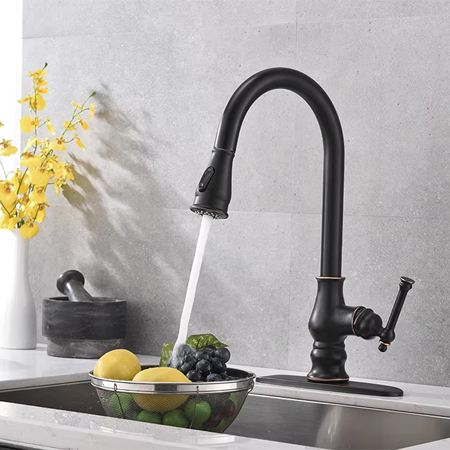
Oil Rubbed Bronze
Overview: Dark, richly finished with a rustic or antique look and feel. Oil Rubbed Bronze maintains its aged look and has copper undertones,
which adds warmth to the kitchen.
Durability: Medium to High
Best Use: Traditional, vintage, or rustic kitchens

Matte Black
Overview: A bold, non-reflective finish adding a modern and sophisticated touch. The Matte Black is an easy finish to maintain since
fingerprints and smudges do not generally show.
Durability: High
Best Use: Modern and minimalist kitchens
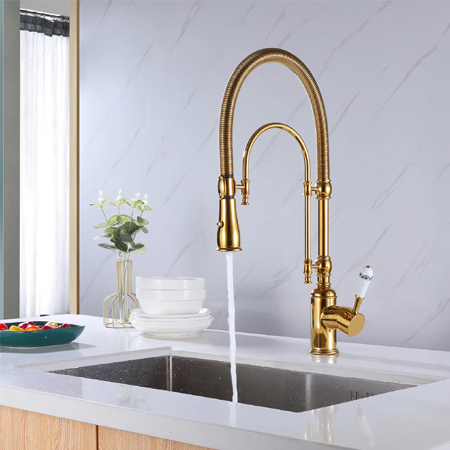
Polished Brass
Overview: Shiny, gold-toned finish with a vintage or classic appeal. Polished Brass is very reflective but may require additional maintenance to keep it shining.
Durability: Medium to High depending on the protective coatings
Best Use: Traditional or classic kitchen
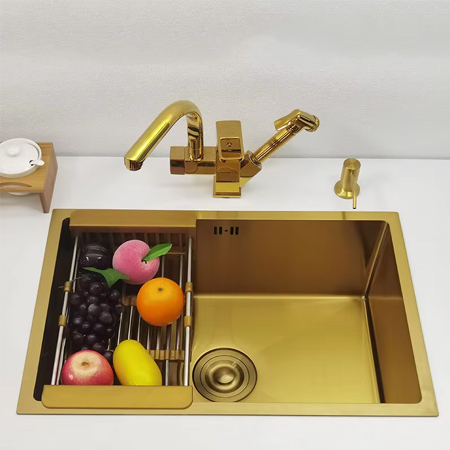
Brushed Gold
Overview: Brushed Gold provides a wealthy and sophisticated finish with a warm tone while providing just a whisper of texture to inhibit the appearance of fingerprints.
This is a softer alternative to polished brass. It has a high rating in terms of durability. The best use is in high-end, transitional, or eclectic kitchens.

Satin Nickel
Overview: Much similar to brushed nickel, Satin Nickel bears a matte, somewhat reflective finish bearing a warm tone. It doesn't tarnish and masks fingerprints and water spots.
This also has high ratings in terms of durability. The best use is in transitional and modern kitchens.
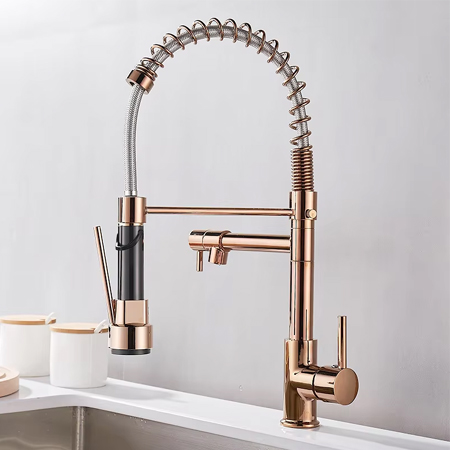
Copper
Overview: Copper is a one-of-a-kind finish featuring a warm, reddish-brown color. Copper tends to patina naturally and must be polished regularly to avoid tarnishing.
Durability: Medium to Low (requires regular care).
Best Use: Farmhouse, vintage, or rustic kitchens.

White
Overview: A clean and crisp finish, white works very well in contemporary kitchens. White faucets are a little less common and make a bold statement when complemented with light-colored countertops.
Durability: Medium to High, depending on the coating
Best application: for modern or coastal kitchens

Bronze
Overview: It has a deep and rich finish with an aged look that is, in general, much darker than oil-rubbed bronze.
This finish adds elegance and warmth to the kitchen
Durability: High
Best suited for: Traditional, rustic, or Mediterranean kitchens
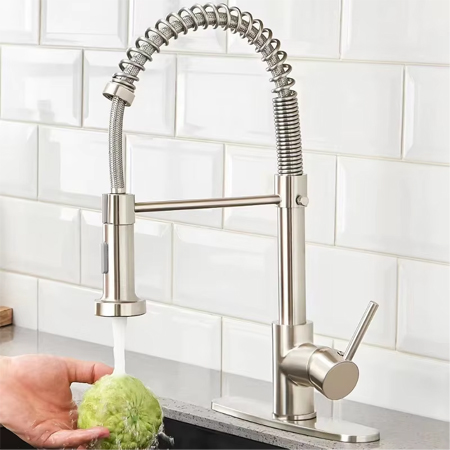
Polished Nickel
Overview: Highly polished, chrome-like finish with a warm undertone. Adding polished nickel to your kitchen creates an air of luxury and sophistication.
Durability: High
Best Use: Luxury, traditional, transitional kitchens
Antique Brass
Overview: Weathered, aged finish adds a vintage touch to any room. Antique Brass is generally darker and less shiny than polished brass, so it creates a classic look.
Durability: Medium
Best Application: Traditional, vintage, or eclectic kitchens
These finishes range in style and in their level of maintenance, to suit any kitchen design and personal preference.
The finish selected will impact the overall look of the faucet, but also
functionality related to cleaning and maintenance.
Design Elements ...
FAQ Kitchen Faucets
Care & Maintenance
Read More
What Variety of Kitchen Faucets Can I Expect?
They include single-handle, double-handle, pull-down, pull-out, touchless, and commercial-style faucets.
How to Choose the Right Kitchen Faucet?
Consider sink type, functionality, style, and installation requirements for a faucet.
What are Some Good Points About a Pull-Down Vs. Pull-Out Faucet?
Pull-down faucets have a better reach into deep sinks, while pull-out faucets provide much more flexibility/moveability.
What Is a Touchless Kitchen Faucet, and How Does It Work?
A touchless faucet is equipped with a sensor to feel hand movements, which allows the on-and-off switching of water without touching the faucet.
How Do I Maintain My Faucet?
Clean the faucet regularly with mild soap and water. Check for leaks and replace worn-out parts such as aerators and cartridges.
What Are the Advantages of a Single-Handle Faucet?
Single-control faucets are easier to operate and offer faster temperature changes, all with the use of one hand.
Are Touchless Faucets Reliable?
Yes, touchless faucets are reliable and convenient. Most of them have long battery life or are plug-in types.
What Should I Consider When Replacing My Kitchen Faucet??
Consider the holes that are already in your sink, the water pressure of your house, and any special features you may need like a sprayer or soap dispenser.
How Do I Fix a Leaky Kitchen Faucet?
Locate where it is leaking from, whether at the handle, from the spout, or at the base, then replace washers, O-rings, or cartridges as damaged.
Which Finishes Are Most in Demand?
The most popular ones are chrome, stainless steel, brushed nickel, matte black, and oil-rubbed bronze.
What Is a High-Arc vs. Low-Arc Faucet?
High-arc models give space to clean large pots and pans, and low-arc models are compact varieties suitable for small sinks.
How Does Water Pressure Affect Faucet Performance?.
The adequate performance of a faucet needs enough pressure of water; if there is low pressure, then checks on the aerator or the supply lines are in order.
Can I Install a Kitchen Faucet Myself??
Yes, the vast majority of can be installed using basic tools and a little knowledge of plumbing; however, the complex models may have to be fitted by a professional.
What are some advantages of commercial-style faucet?
Commercial style faucets feature high flow rates and are solidly built. More than that, they come with flexible spray hoses, which makes them a perfect solution for heavy-duty operation in the kitchen.
Regular cleaning and application of vinegar-water mixture can clean all sort of mineral deposits on your faucet.
|
|
 |
 |
 |
 |

|



 Perfect Faucet
Perfect Faucet 



 Contemporary design
Contemporary design